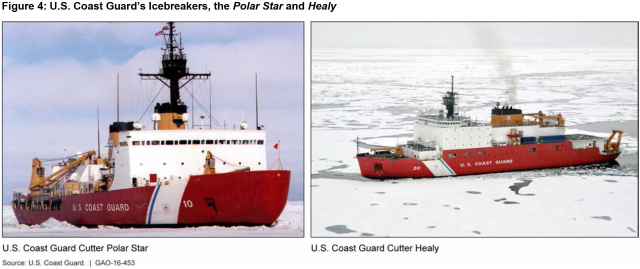Obstacles Ahead for U.S. Icebreakers
 If there’s a star in this fleet right now, it’s the Polar Star, a heavy icebreaker that is the world’s most powerful active non-nuclear icebreaker. It is capable of ramming through ice 21 feet thick and operating year-round in both polar regions.
The Healy, a medium icebreaker, cannot access the Antarctic year-round or some of the Arctic in winter because it cannot make it through more than 4½ feet of ice. It primarily supports Arctic research.
A little creaky
The Polar Star first set sail in the mid-1970s, and the Healy in 1999. The Coast Guard projects that the Polar Star’s service life will end in 2023 and the Healy’s by 2030.
If there’s a star in this fleet right now, it’s the Polar Star, a heavy icebreaker that is the world’s most powerful active non-nuclear icebreaker. It is capable of ramming through ice 21 feet thick and operating year-round in both polar regions.
The Healy, a medium icebreaker, cannot access the Antarctic year-round or some of the Arctic in winter because it cannot make it through more than 4½ feet of ice. It primarily supports Arctic research.
A little creaky
The Polar Star first set sail in the mid-1970s, and the Healy in 1999. The Coast Guard projects that the Polar Star’s service life will end in 2023 and the Healy’s by 2030.
 This fleet has degraded a bit in recent years. From fiscal 2010-2013, the heavy icebreakers were inactive due to maintenance needs. Partially due to the ships’ unavailability, the Coast Guard was unable to fulfill all of its polar icebreaking requests during fiscal years 2010-2016—completing 78% (25 of 32) of them.
An accelerated icebreaker replacement process?
The Coast Guard partnered with the Navy in 2013 and initiated an acquisition program for three heavy icebreakers, the first of which is estimated to cost about $1 billion. However, we found that the Coast Guard may not be able to meet its schedule and acquire a heavy icebreaker by 2023.
Facing a potential gap in its ability to maintain heavy icebreaking capability, the Coast Guard plans to extend the service life of the Polar Star until its new icebreakers arrive. However, it has not produced a sound estimate of the cost of doing that.
We recommended the Coast Guard complete a comprehensive cost estimate for a life extension of the Polar Star that follows cost estimating best practices before committing to this approach.
Learn more here about the Coast Guard’s polar icebreaker acquisition program and other efforts to ensure the service can meet requests for polar icebreaking operations.
This fleet has degraded a bit in recent years. From fiscal 2010-2013, the heavy icebreakers were inactive due to maintenance needs. Partially due to the ships’ unavailability, the Coast Guard was unable to fulfill all of its polar icebreaking requests during fiscal years 2010-2016—completing 78% (25 of 32) of them.
An accelerated icebreaker replacement process?
The Coast Guard partnered with the Navy in 2013 and initiated an acquisition program for three heavy icebreakers, the first of which is estimated to cost about $1 billion. However, we found that the Coast Guard may not be able to meet its schedule and acquire a heavy icebreaker by 2023.
Facing a potential gap in its ability to maintain heavy icebreaking capability, the Coast Guard plans to extend the service life of the Polar Star until its new icebreakers arrive. However, it has not produced a sound estimate of the cost of doing that.
We recommended the Coast Guard complete a comprehensive cost estimate for a life extension of the Polar Star that follows cost estimating best practices before committing to this approach.
Learn more here about the Coast Guard’s polar icebreaker acquisition program and other efforts to ensure the service can meet requests for polar icebreaking operations.
- Questions on the content of this post? Contact Nathan Anderson at andersonn@gao.gov.
- Comments on GAO’s WatchBlog? Contact blog@gao.gov.

GAO's mission is to provide Congress with fact-based, nonpartisan information that can help improve federal government performance and ensure accountability for the benefit of the American people. GAO launched its WatchBlog in January, 2014, as part of its continuing effort to reach its audiences—Congress and the American people—where they are currently looking for information.
The blog format allows GAO to provide a little more context about its work than it can offer on its other social media platforms. Posts will tie GAO work to current events and the news; show how GAO’s work is affecting agencies or legislation; highlight reports, testimonies, and issue areas where GAO does work; and provide information about GAO itself, among other things.
Please send any feedback on GAO's WatchBlog to blog@gao.gov.
